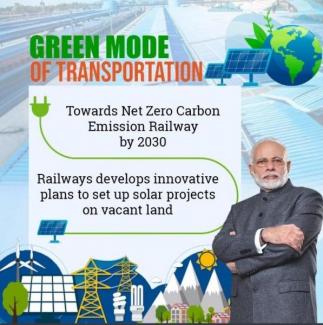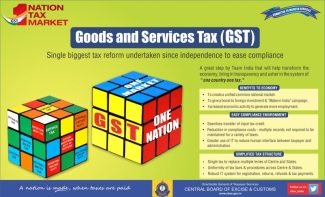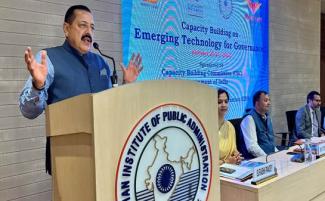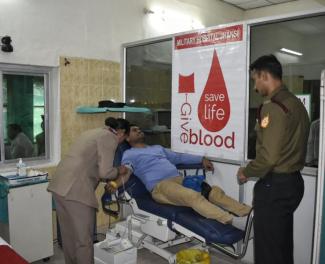
In order to achieve its objective of becoming 100% self sustainable for all it's power needs and also to contribute to national solar power goals, Indian Railways organized wide ranging discussions with key stake holders under the chairmanship of Minister of Railways and Commerce & Industry Piyush Goyal.
It may be noted that Indian Railways is committed to utilize solar energy for meeting its traction power requirement and become a complete ‘Green mode of transportation’.
The primary areas of discussion in this meeting were as follows:
1. Innovative solutions for setting up solar projects along the railway track.
2. Possible power procurement routes for achieving 20 GW renewable energy target, set by the Indian Railways, to become the net zero carbon emitter by 2030.
3. Challenges in large scale deployment of solar energy projects by the Indian Railways.
The developers acknowledged the efforts of Indian Railways in leading the development of renewable energy in the country and expressed strong support to Indian Railways on the path of going green and achieving the net zero carbon emissions target by 2030.
This is in line with the recent directive of Prime Minister to solarise railway stations and utilize vacant railway land for Renewable Energy (RE) projects.
It will also contribute towards National Solar Mission, an initiative of the Government of India to promote solar power.
As a follow up, it has been decided by Ministry of Railways to provide solar power plants on vacant unused Railway land on mega scale. A pilot project of 1.7 MW capacity with direct connectivity to 25 KV traction system has been successfully operationalised in Bina. In addition, solar plant of 3 MW capacity has also been commissioned at Modern Coach Factory (MCF), Raebareli for non-traction applications. Further, 2 more projects – one at Diwana for 2 MW and another at Bhilai for 50 MW capacity for connectivity with State Transmission Utility (STU) and Central Transmission Utility (CTU) respectively are in progress.
The use of solar power will accelerate the Minister of Railways and Commerce & Industry, Piyush Goyal’s mission to achieve conversion of Indian Railways to ‘Net Zero Carbon Emission Railway’. In order to achieve this, Indian Railways has developed a mega plan for installing solar plants of 20 GW capacity by utilizing its vacant land by 2030. With the ambitious plan of achieving 100% electrification for Railways by the year 2023, Indian Railways energy consumption is set to become more than 33 billion units by 2030 from its current annual requirement of about 21 billion units.
Indian Railways has adopted a multi-pronged approach towards decarbonization which would be fulfilled by the solar projects being deployed, making it the first transport organization to be energy self-sufficient. This would help in making Indian Railways green as well as ‘Atma-Nirbhar’.
In this regard, to begin with, bids for 3 GW solar projects on vacant Railway land parcels and land parcels along the railway track have already been invited by Railway Energy Management Company Ltd. (REMCL), a PSU of Indian Railways. These solar projects, besides supplying power to Railways at reduced tariff, will also protect the Railway land by construction of boundary wall along the track.
Goyal pointed out that Indian Railways is willing to extend all support to the developers for installing solar power plants on Railway’s vacant un-encroached land. Boundary wall along the track will be constructed and maintained by developers which will also help in preventing trespassing on tracks.
Adoption of modern indigenous technology to create an energy self-reliant Indian Railways will contribute towards meeting India’s renewable energy targets and Intended Nationally Determined Contributions (INDCs), as committed by Prime Minister, Narendra Modi.
भारतीय रेलवे 2030 तक ऊर्जा खपत जरूरतों को पूरा करने के लिए तैयार
भारतीय रेलवे अपनी अतिक्रमण नहीं की गई खाली भूमि पर सौर ऊर्जा संयंत्र स्थापित करने के लिए डेवलपर्स को पूरा सहयोग देगी
रेलवे का वर्ष 2023 तक 100 प्रतिशत विद्युतीकरण करने का लक्ष्य
अपनी ऊर्जा की सभी जरूरतों को पूरा करने के लिए शत-प्रतिशत (100%) आत्मनिर्भर बनने के लक्ष्य को हासिल करने और साथ ही राष्ट्रीय सौर ऊर्जा लक्ष्यों में योगदान देने के लिए, भारतीय रेलवे ने रेलवे और वाणिज्य और उद्योग मंत्री पीयूष गोयल की अध्यक्षता में प्रमुख हितधारकों के साथ व्यापक बातचीत आयोजित की।
इस बात पर गौर किया जा सकता है कि भारतीय रेलवे अपनी कर्षण या खींचने की शक्ति की आवश्यकता को पूरा करने और परिवहन का एक पूर्ण 'ग्रीन मोड' बनने के लिए सौर ऊर्जा के उपयोग के लिए प्रतिबद्ध है।
इस बैठक में चर्चा के प्राथमिक क्षेत्र इस प्रकार थे:
1. रेलवे ट्रैक के बगल में सौर परियोजनाएं स्थापित करने के लिए नवीन समाधान।
2. भारतीय रेलवे द्वारा 2030 तक शुद्ध शून्य कार्बन उत्सर्जक बनने के निर्धारित समय तक 20 गीगावाट अक्षय ऊर्जा लक्ष्य हासिल करने के लिए संभावित बिजली खरीद क्रम।
3. भारतीय रेलवे द्वारा बड़े पैमाने पर सौर ऊर्जा परियोजनाएं लगाने में चुनौतियां।
डेवलपर्स ने देश में नवीकरणीय ऊर्जा के विकास में अग्रणी भारतीय रेलवे के प्रयासों को स्वीकार किया और 2030 तक भारतीय रेलवे को हरित होने और शुद्ध शून्य कार्बन उत्सर्जन लक्ष्य प्राप्त करने के रास्ते पर मजबूती से सहयोग देने की इच्छा व्यक्त की।
यह रेलवे स्टेशनों में सौर ऊर्जा का इस्तेमाल करने और रेलवे की खाली पड़ी भूमि का नवीकरणीय ऊर्जा (आरई) परियोजनाओं के लिए उपयोग करने के माननीय प्रधानमंत्री के हालिया निर्देशों की तर्ज पर है।
यह सौर ऊर्जा को बढ़ावा देने के लिए भारत सरकार की एक पहल, राष्ट्रीय सौर मिशन की दिशा में भी योगदान देगा।
बीना में 25 केवी ट्रैक्शन सिस्टम से सीधी कनेक्टिविटी के साथ 1.7 मेगावाट क्षमता की पायलट परियोजना सफलतापूर्वक काम करने लगी है। इसके अलावा, गैर-अनुवीक्षण अनुप्रयोगों के लिए रायबरेली में आधुनिक कोच फैक्टरी (एमसीएफ) में 3 मेगावाट क्षमता का सौर संयंत्र भी चालू किया गया है। इसके अलावा, राज्य ट्रांसमिशन उपयोगिता (एसटीयू) और केंद्रीय ट्रांसमिशन उपयोगिता (सीटीयू) के साथ कनेक्टिविटी के लिए क्रमश: 2 और परियोजनाएं - 2 मेगावाट की दीवाना में और 50 मेगावाट क्षमता की भिलाई में प्रगति पर हैं।
सौर ऊर्जा के उपयोग से रेल और वाणिज्य और उद्योग मंत्री पीयूष गोयल के रेलवे को 'शुद्ध शून्य कार्बन उत्सर्जन रेलवे' में बदलने के मिशन को हासिल करने में तेजी आएगी। इसे प्राप्त करने के लिए, भारतीय रेलवे ने 2030 तक अपनी खाली भूमि का उपयोग करके 20 गीगावाट क्षमता के सौर संयंत्र स्थापित करने के लिए एक बहुत बड़ी योजना विकसित की है। रेलवे की वर्ष 2023 तक 100 प्रतिशत विद्युतीकरण प्राप्त करने की महत्वाकांक्षी योजना के साथ, भारतीय रेलवे की ऊर्जा की खपत 2030 तक 33 बिलियन यूनिट से अधिक हो जाएगी जबकि वर्तमान वार्षिक आवश्यकता लगभग 21 बिलियन यूनिट है।
भारतीय रेलवे ने डीकॉर्बोनाइज़ेशन के लिए एक बहु-आयामी दृष्टिकोण अपनाया है जिसे लगाई जा रही सौर परियोजनाओं द्वारा पूरा किया जाएगा, इससे यह ऊर्जा के क्षेत्र में आत्मनिर्भर होने वाला पहला परिवहन संगठन बन जाएगा। इससे भारतीय रेलवे को हरा-भरा और साथ ही आत्म-निर्भर बनाने में मदद मिलेगी।
इस संबंध में, रेल पटरी के बगल में रेलवे की खाली भूमि के टुकड़े और रेलवे की सम्पत्ति पर 3 गीगावाट की सौर परियोजनाओं के लिए भारतीय रेलवे का सार्वजनिक क्षेत्र उपक्रम,रेलवे ऊर्जा प्रबंधन कंपनी लिमिटेड (आरईएमसीएल) पहले ही बोलियां लगा चुका है। इन सौर परियोजनाओं से, रेलवे को कम शुल्क पर बिजली की आपूर्ति करने के अलावा, पटरी के साथ-साथ चारदीवारी के निर्माण से रेलवे की भूमि की रक्षा भी की जा सकेगी।
रेल और वाणिज्य और उद्योग मंत्री श्री पीयूष गोयल ने बताया कि भारतीय रेलवे, रेलवे की अतिक्रमण नहीं की गई खाली भूमि पर सौर ऊर्जा संयंत्र स्थापित करने के लिए डेवलपर्स को हर प्रकार का सहयोग देने को तैयार है। पटरी के साथ चारदीवारी का निर्माण और रखरखाव डेवलपर्स द्वारा किया जाएगा जो पटरियों पर अतिक्रमण रोकने में भी मदद करेगा।
आधुनिक स्वदेशी प्रौद्योगिकी को अपनाकर ऊर्जा की दृष्टि से आत्मनिर्भर रेलवे भारत के नवीकरणीय ऊर्जा लक्ष्यों और राष्ट्रीय स्तर पर निर्धारित अंशदान (आईएनडीसी) को पूरा करने में योगदान देगी, जैसा कि हमारे प्रधानमंत्री नरेन्द्र मोदी की प्रतिबद्धता है।











